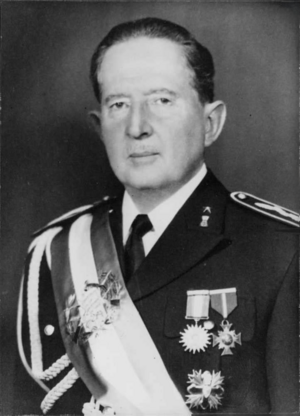Miguel Ydígoras Fuentes facts for kids
Quick facts for kids
General of Division
Miguel Ydígoras Fuentes
|
|
|---|---|
 |
|
| 32nd President of Guatemala | |
| In office 2 March 1958 – 31 March 1963 |
|
| Preceded by | Guillermo Flores Avendaño |
| Succeeded by | Enrique Peralta Azurdia |
| Personal details | |
| Born | 17 October 1895 Retalhuleu, Guatemala |
| Died | 27 October 1982 (aged 87) Guatemala City, Guatemala |
| Political party | National Democratic Reconciliation Party |
| Spouse | Maria Teresa Laparra (1901–1988) |
General José Miguel Ramón Ydígoras Fuentes (born October 17, 1895 – died October 27, 1982) was a leader of Guatemala. He served as the President of Guatemala from 1958 to 1963. Before becoming president, he was a main challenger in the 1950 presidential election. He also worked as the governor of the San Marcos region.
Contents
Early Life and Military Career
Miguel Ydígoras Fuentes was born on a coffee farm in Pueblo Nuevo, Guatemala. This was on October 17, 1895. He loved coffee very much, drinking many cups a day. He called it a "patriotic vice" because Guatemala produced a lot of coffee.
He went to Guatemala's military academy. He finished at the very top of his class in 1915. Later, he worked at Guatemalan embassies in Washington, D.C., and Paris. He even represented Guatemala at a big peace meeting in Paris in 1919.
Serving Under a Dictator
In 1922, Ydígoras became the governor of the San Marcos region. He was made a general in 1937. He served as governor under a leader named Jorge Ubico. Ubico was a dictator, meaning he had total control of the country.
After Ubico was removed from power in 1944, Ydígoras was sent away. He went to Washington, D.C., and then London. This was like a diplomatic exile, meaning he had to leave the country for political reasons.
Presidential Election of 1950
Ydígoras returned to Guatemala in 1950. He ran for president against Jacobo Árbenz. The election was mostly fair. However, women who could not read were not allowed to vote.
Ydígoras had support from landowners. But he did not have much support from regular people. Árbenz won the election by a large number of votes.
CIA and the 1954 Coup
The United States' Central Intelligence Agency (CIA) thought about Ydígoras to lead a plan. This plan was to remove Árbenz from power in 1954. But they chose Carlos Castillo Armas instead. They thought Ydígoras might not be popular with most Guatemalans.
Ydígoras later said that the CIA offered him help to remove Árbenz. He claimed he refused their first offer. He said their terms included favoring a big company and setting up a dictatorship. Later, Ydígoras agreed to help Castillo Armas.
Becoming President of Guatemala
Carlos Castillo Armas was sadly killed in 1957. New elections were held soon after. These first elections were not fair, so people protested. Another election was held in 1958, and Ydígoras was elected president.
Challenges During His Presidency
During his time as president, there were many reports of corruption. This means people in power were using their positions for personal gain. There was also a lot of social unrest. People often protested against the government.
These protests eventually led to the start of a guerrilla group. A guerrilla group is a small army that fights against a larger, regular army. This group was called MR-13.
Bay of Pigs Invasion
In 1961, Ydígoras allowed the CIA to train Cuban exiles in Guatemala. These exiles were preparing for an invasion of Cuba. This invasion, known as the Bay of Pigs Invasion, did not succeed.
End of His Presidency
Several attempts were made to remove Ydígoras from power. These attempts are called coups. A coup is when a group, often military, tries to take control of a government by force. All early attempts failed.
However, in 1963, Ydígoras's defense minister, Colonel Enrique Peralta Azurdia, took over. Peralta claimed that the government had been taken over by communists. He ended the constitution and became the new head of state. Many opposition groups supported Peralta's coup. They wanted to stop the former president, Juan José Arévalo, from running for president again.
Later Life and Legacy
Later in his life, Ydígoras felt upset about the failure of the Bay of Pigs invasion. He was in exile in El Salvador in 1974. He said he was blamed unfairly for the failure. He also believed the United States was responsible for his removal from power.
Miguel Ydígoras Fuentes passed away on October 27, 1982. He was 87 years old. He died in a military hospital in Guatemala City from a cerebral hemorrhage, which is a type of bleeding in the brain. He was survived by his wife and two children.
Sources
| Government offices
|
||
|---|---|---|
| Preceded by Guillermo Flores |
President of Guatemala 1958–1963 |
Succeeded by Enrique Peralta |
See also
 In Spanish: Miguel Ydígoras Fuentes para niños
In Spanish: Miguel Ydígoras Fuentes para niños

